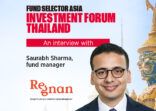Volatility is increasing in Asian markets, driven by events in China.
The correction in the onshore market, the government measures to stabilise markets, and the weakening of the currency have sent mixed signals to investors. Uncertainty has weighed heavily not only on the region but also on global markets.
The US Federal Reserve is likely to raise rates later this year, increasing market volatility in the region.
The most vulnerable asset class is perhaps small-caps and to an extent mid-caps. These companies are typically volatile compared to their large-cap counterparts. During periods of market stress, they could be hit hard.
Liquidity is another issue. Small-caps are not as widely traded as large-caps and during volatile market periods, managers could face problems selling these stocks to meet investors’ redemption commitments, unless they maintain an adequate cash buffer.
Yet market volatility also offers opportunity to invest small- and mid-caps at attractive valuations. Managers like Manulife beleive there are wide range of small-cap opportunities in the region.
Against this backdrop, Fund Selector Asia compares the Allianz Little Dragons and the JO Hambro Asia ex-Japan Small and Mid Cap Fund, funds that target investments in small- and mid-cap companies.
Both funds have similar investment approach, but the key difference is in how they define market capitalisation for investments.
Luke Ng, senior vice president at FE Advisory Asia, has provided a comparative analysis.
Investment Strategy review
Both funds use different benchmark indices, resulting in a deviation in the market capitalisation focus of companies targeted for investments, said Ng.
The Allianz fund benchmarks its performance against the MSCI AC Asia ex-Japan Mid Cap Index while the JO Hambro fund uses the MSCI AC Asia ex-Japan Small Cap Index as its benchmark.
“The Allianz team intends to invest in companies with a maximum market cap of 1.3 times the largest security in the respective benchmark.”
The largest constituent in the MSCI AC Asia ex-Japan Mid Cap Index has a market capitalisation of about $13.5bn as of July-end, Ng pointed out.
On the other hand, the JO Hambro fund focuses on small-to-mid-cap companies with market capitalization of less than $4bn.
While market cap focus differs, there are similarities in investment philosophy.
“The Allianz team primarily adopts a bottom-up selection approach and would also take macro factors into consideration.”
Apart from fundamental research and company visits, the Allianz team also gets input from Grassroots Research, a division within Allianz that uses a global network of journalists and industry contacts to help the firm identify stock and sector trends, Ng said.
The JO Hambro approach is not much different. Fund manager Cho-Yu Kooi and her team mainly employ a fundamental stock selection approach to identify smaller companies that are demonstrating long-term sustainable growth prospects, said Ng.
“Strong attention is paid to regular interaction with company management, and via thorough analysis, the team intends to take a long-term investment view in constructing the portfolio.
“Cho-Yu expects around 70% of the portfolio’s returns to be generated by a fundamental bottom-up selection approach, and the remainder is expected to come from a top-down approach, as Asian markets are often impacted by political and macro factors.
“Therefore, quality growth stocks are often blended with some cyclical exposure based on the team’s top-down views, and these stocks are mainly valuation focused.”
Both funds hold a concentrated portfolio of around 50-60 stocks.
Looking at country allocation, the Allianz fund has been overweight China/Hong Kong and India.
“The Allianz fund’s benchmark index (the mid-cap Index) has a stronger exposure to China/Hong Kong and naturally Allianz’s China/Hong Kong positions are higher relative to the JOHCM fund.”
In terms of sectors, the Allianz team is overweight industrials and technology.
The JO Hambro team is overweight India and Taiwan, said Ng. But it has zero exposure to Korea, which has a 20% weighting in its benchmark index.
The team sees opportunities in consumer discretionary and technology companies.
A snapshot of portfolio allocation:

 Source: Fund fact sheets on 31 July
Source: Fund fact sheets on 31 July














